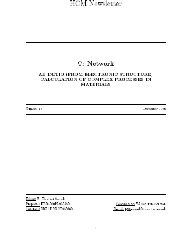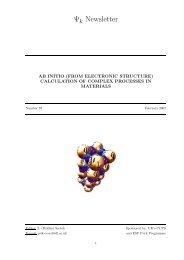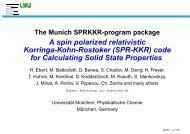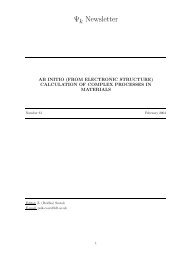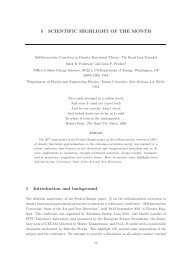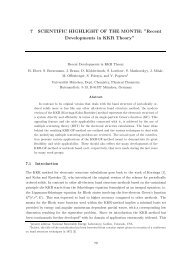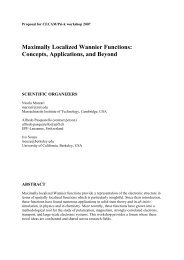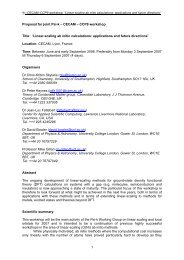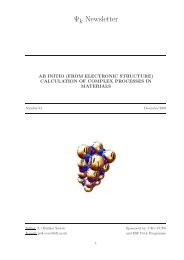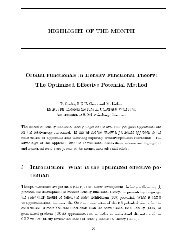Newsletter 107 - October 2011 - (pdf - 0.6 MB) - Psi-k
Newsletter 107 - October 2011 - (pdf - 0.6 MB) - Psi-k
Newsletter 107 - October 2011 - (pdf - 0.6 MB) - Psi-k
Create successful ePaper yourself
Turn your PDF publications into a flip-book with our unique Google optimized e-Paper software.
Large variation of vacancy formation energies in the surface of<br />
crystalline ice<br />
M. Watkins 1,2,3 , D. Pan 4 , E. G. Wang 5 , A. Michaelides 1,2,3 , J. VandeVondele 6<br />
& B. Slater 1,3<br />
1 Department of Chemistry, Christopher Ingold Building, 20 Gordon Street,<br />
University College London, London WC1H 0AJ, UK<br />
2 London Centre for Nanotechnology, University College London,<br />
London WC1H 0AJ, UK<br />
3 TYC@UCL, University College London, London WC1H 0AJ, UK<br />
4 Institute of Physics, Chinese Academy of Sciences,<br />
PO Box 603, Beijing 100190, China<br />
5 School of Physics, Peking University, Beijing 100871, China<br />
6 Institute of Physical Chemistry, University of Zurich,<br />
Winterthurerstrasse 190, CH-8057 Zurich, Switzerland<br />
Abstract<br />
Resolving the atomic structure of the surface of ice particles within clouds, over the temperature<br />
range encountered in the atmosphere and relevant to understanding heterogeneous<br />
catalysis on ice, remains an experimental challenge. By using first-principles calculations,<br />
we show that the surface of crystalline ice exhibits a remarkable variance in vacancy formation<br />
energies, akin to an amorphous material. We find vacancy formation energies as<br />
low as 0.10.2eV, which leads to a higher than expected vacancy concentration. Because a<br />
vacancys reactivity correlates with its formation energy, ice particles may be more reactive<br />
than previously thought. We also show that vacancies significantly reduce the formation<br />
energy of neighbouring vacancies, thus facilitating pitting and contributing to pre-melting<br />
and quasi-liquid layer formation. These surface properties arise from proton disorder and<br />
the relaxation of geometric constraints, which suggests that other frustrated materials may<br />
possess unusual surface characteristics.<br />
(Published in Nature Materials )<br />
Contact person: b.slater@ucl.ac.uk<br />
39




